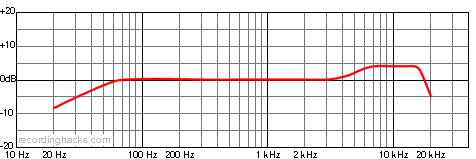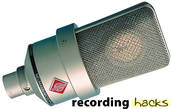 Neumann TLM 103
Neumann TLM 103
Cardioid Condenser Microphone
The TLM 103 is a fixed-cardioid, large-diaphragm FET microphone intended for the project-studio market. Neumann considers it a low-budget microphone, although its street price is about $1000.
 The TLM103’s capsule, called the K103, is “based on the K87, well known from the U-67 / U-87 microphones.” In fact it is a derivation of the K67 capsule, with a similar pattern to the backplate drilling, but fewer overall holes.
The TLM103’s capsule, called the K103, is “based on the K87, well known from the U-67 / U-87 microphones.” In fact it is a derivation of the K67 capsule, with a similar pattern to the backplate drilling, but fewer overall holes.
Klaus Heyne
[The K103 capsule] consists of one half of a [K87 derivative] and the other half, instead of being the identical twin of the front side, consists of a brass backplate with some strategically drilled acoustic through-holes. There is no membrane on the back.
Rick Chinn
The K103 has increased output over the K87 because of the reduced membrane to backplate distance, resulting in higher output for the same SPL.
The mic has very low self-noise, and is very sensitive, making it appropriate for quiet acoustic sources.
There is no pad nor high-pass filter. The capsule assembly is shockmounted inside the headbasket, but the mic’s high sensitivity means it will likely “hear” footsteps and and other noises transmitted mechanically via the mic stand. The use of an elastic shockmount is recommended.
The amplifier circuit is made with surface-mount components. The output circuit is transformerless.
The mic is available in two colors, satin nickel and matte black. Both include a metal swivel mount (p/n SG 1) and a wooden jeweler’s box. Also available as a “stereo set,” including two mics and two elastic shockmounts in an aluminum case, and a “studio set,” which is the stereo set without the flightcase.
Neumann
The capsule has a flat frequency response up to about 5 kHz, and above that, a wide flat 4 dB presence boost.
MIX
Due to the mic’s low self-noise and distortion, you could use a hyper-EQ shape and/or an extremely squashed and spanking compressor setting and not highlight any microphone shortcomings. I found applications where I preferred the TLM 103 over anything else in the mic cabinet. It was excellent on drums, harmonica and sax as well as certain singers who would also sound good on a U87.
SoundOnSound
Essentially, the TLM103 has a big, open, natural character, which has a tendency to sound warm and full rather than thin and clinical. It may not be completely accurate, but it is certainly musical and can easily be used to the advantage of the recording. The polar pattern is as accurate as it can be with a large-diaphragm capsule, and provides good front-back rejection combined with clean-sounding off-axis pickup…
If you are looking for a very high-quality, general-purpose mic, this has to be one to add to your list.
The mic won a TEC award in 1998 for “technical excellence and creativity … in microphone technology.”
Rick Chinn
The TLM 103 has a warm sound, without being dull. On acoustic guitar, the overall tonal balance is excellent without any EQ. The string jangle is pleasing, and the overall sound sits easily in the front of the mix. In comparison, the U87A sounds middy and a bit thin; decidedly a different sound that might work in a different context. The C414-TL-II is a bit closer sounding; with a similar high-end texture: present without being exaggerated.
The Neumann TLM 103 is also known as: TLM103, TLM 103.
The mic was released in 1997.
Specifications
| Frequency Response - CardioidClick Graph to Compare! |
|---|
 |
| Pickup Patterns | Pads & Filters |
|---|---|
|
Cardioid
(23 mV/Pa; 20 - 20,000 Hz) |
|
| Capsule Dimensions | Impedance | SPL/Noise |
|---|---|---|
| Diameter n/a |
50 Ohms (Low) | Max SPL: 138 dB Self-noise: 7.0 dB(A) |
| Weight | Length | Max Diameter | Interface(s) |
|---|---|---|---|
| 500g (17.64oz) | 132mm (5.20'') | 60mm (2.36'') |
|
| Power Specifications |
|---|
|
Did we get anything wrong on this page? Please let us know!

